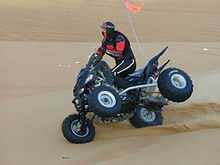Quad bike

A Quad bike is recognised by UK law as a vehicle with four wheels and a mass of less than 550 kg.[1][2] To drive a quad bike on a public road, in the UK, requires a B1 licence as well as tax, insurance and registration.
History
19th century
Royal Enfield built and sold the first powered quadracycle in 1893. It had many bicycle components, including handle bars. The Royal Enfield resembles a modern ATV-style quad bike but was designed as a form of horseless carriage for road use.[3]
20th century
In the 1970s Honda started to make trikes and quad bikes based on their motorbikes which became the modern UK quad bike.[4]
Controversy

The safety issues of cars classed as quad bikes are illustrated by the case of the G-Wiz (REVA). This neighborhood electric vehicle is seen by some within British motor journalism as a symbol of champagne socialism[5] because of its popularity with some celebrities and its poor performance in almost all fields. The vehicle was given a Euro NCAP specification test. The results showed that the vehicle's occupants would suffer "serious or life-threatening" injuries in a 64 km/h (40 mph) crash.[6] The UK Department for Transport concluded that there were serious safety concerns when the REVA was crashed at 35 mph (56 km/h).
Safety has been a major issue with quad-bikes due to the high number of deaths and injuries associated with them and the negligible protection offered by the machine.
After consultation with stakeholders including farmers and quad-bike manufacturers, Australia's Heads of Workplace Safety Authorities (HWSA) representing all states and territories, as well as New Zealand, in 2011 released a strategy intended to reduce the high number of deaths and serious injuries associated with quad-bike use. Apart from encouraging standard safety measures such as helmet-wearing, the strategy also recommend development of a national training curriculum, point of sale material for purchasers and, controversially, a recommendation that owners consider fitting of an after-market anti-crush device which may offer added protection in the event of a roll-over. At the time the report was released the only model of anti-crush protection on the market was the Australian-made "Quad bar" which was vigorously opposed by the industry through media activity and a poster campaign at regional events for farmers which are often used to showcase new products. The industry argued that the device had not been properly tested and that past studies of tractor-style ROPS such as a full-frame 'cage' around the operator were not only ineffective, but could add to the risk to injury or death. While quad-bike safety has mainly focused on users operating the machines correctly, the fundamental design has not been a public focus of the industry despite the high potential for rollovers and deaths which are frequently reported in media around the world.[7][8][9][10][11][12]
See also
References
- ↑ "Your full driving license". DVLA. 2006-08-18. Retrieved 2008-04-16.
- ↑ "Quad bikes: the rules". GOV.UK. Retrieved 2013-07-25.
- ↑ Royal Enfield Early History (Retrieved 10 June 2008)
- ↑ Chris Cooper. "ATC90 History". Retrieved 2008-06-10.
- ↑ "TopGear Magazine, March 2008, Page 34". Top Gear. 2008-01-03.
- ↑ "G-Wiz crash test news – Electric shock". Top Gear. 2007-05-09. Retrieved 2008-02-28.
- ↑ Quad Bike Industry Solutions Program Trans-Tasman Working Group
- ↑ How safe are Quad bikes
- ↑ Anti-crush ATV campaign
- ↑ Quad bar
- ↑ FCAI Moves to De-Bunk ATV Roll-over Protection Myths
- ↑ Summary of "ATV Roll Over Protection Research" by John Zellner (Part 2/2)